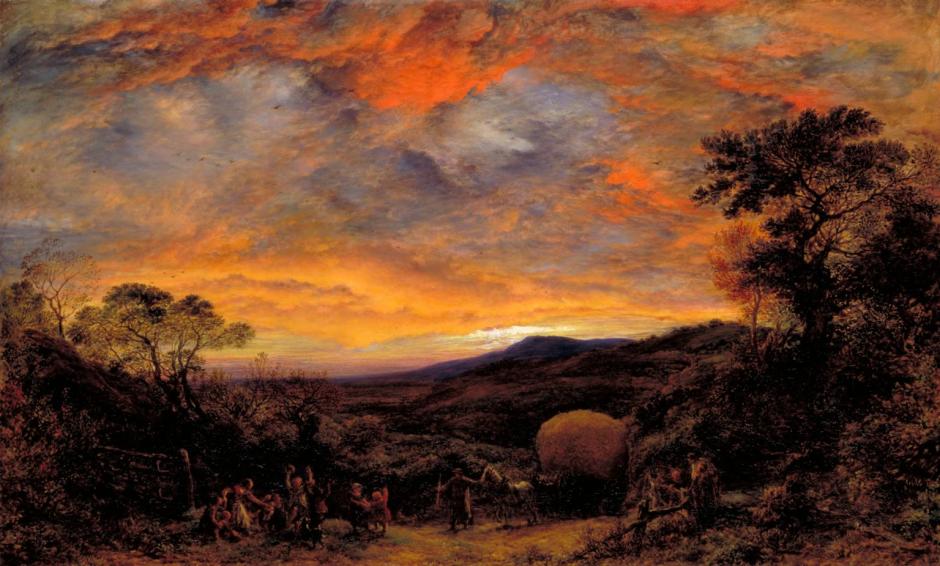At the heart of landscape painting are colour, form and light. It’s only appropriate the letter D in our alphabet covers two of those three, at dawn and dusk, when the dominant greens of the land meet the contrast of red and gold in the sky.
When painting from nature, in particular en plein air, these are the two times of the day when you want to face into the sun, contre jour, rather than having the light behind you or from one side of the view. Try contre jour when the sun is any higher and it rapidly becomes blinding, bleaching all colour from your vision, and limiting sessions to thirty minutes even at lower solar elevations.
The other major limitation of painting these periods in front of the motif is the brief time that colour and light are just right, which can be as fleeting as a few minutes, a serious challenge even for those who work extremely fast. Often, the best that can be managed is a lightning sketch with some colour matches, leaving the painting to be completed from memory.

By the end of the 1630s, Claude Lorrain’s reputation was made as one of the two greatest landscape painters of the period, alongside the other Frenchman in Rome, Nicolas Poussin. Like Poussin, Claude drew and sketched in front of the motif, a practice he showed in An Artist Studying from Nature (1639). Unlike his compatriot, Claude had a lasting love of painting into the setting sun, as here, although all his finished works were made in the studio.

JMW Turner was a great admirer of Claude, and in 1817 painted the Decline of the Carthaginian Empire looking straight into the setting sun, a landscape thinly disguised as a history painting.

John Linnell developed a taste for richly chromatic views such as Harvest Home, Sunset: The Last Load from 1853, showing the final wagonload of cut grain leaving the fields at dusk, as the harvest is completed.

Samuel Palmer’s paintings of dusk took over from those of Turner and Linnell. His Sunset from 1861 is among the best of these, capturing the warm sunlight of the late summer, just before the grain harvest.

In the same year, Ivan Aivazovsky demonstrated why he kept his studio in his home town of Feodosia in Crimea, Ukraine, in Sunset over Yalta (1861). This shows the popular resort city on the southern coast of the peninsula.

When John Atkinson Grimshaw switched to landscapes early in his career, one of his first finely detailed twilight views was this of Lake Windermere from 1863.

Some of the great Swedish natural history painter Bruno Liljefors’ finest works are almost pure landscapes, such as his Hunting Geese from 1896, with its superb mackerel sky of dusk.
While most paintings of dawn or dusk look into the warm light, some reverse direction and show the colours of the rising or setting sun cast on the landscape, with the sun behind the artist.

James Dickson Innes had an affection for these periods of the day, as seen in his Deep Twilight, Pyrenees, painted in 1912-13.

These effects are often most striking when the sun’s red light is colouring a snow-covered mountain, an effect that’s confined to certain locations and seasons. Vasily Vasilyevich Vereshchagin was fortunate enough to get perfect conditions for his view of Mount Kazbek, in the Caucasus range, painted in 1898.

Kangchenjunga in the Himalaya is another example of a mountain that can reward the viewer with an extraordinary vision at dusk. When Nicholas Roerich was living in India in 1844, he caught the light just right in his view of the distant Kangchenjunga, most probably seen from Darjeeling.

Some locations and conditions also work when the light of dusk is coming from the side, as shown in Alfred de Bréanski’s undated Sunset in the Scottish Highlands.
Finally, the warm colours associated with dawn and dusk aren’t essential in more modern landscapes, as shown in James Abbott McNeill Whistler’s Nocturne: Blue and Gold — Southampton Water from 1872.

Whistler painted this on the long broad estuary connecting the port of Southampton to the Solent, on the central south coast of England. In this case, his contre jour is dominated by the colours of its title, with the sun apparently rising rather than setting.

